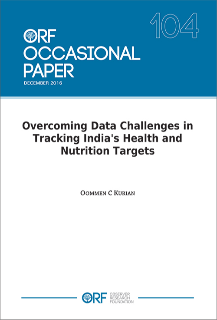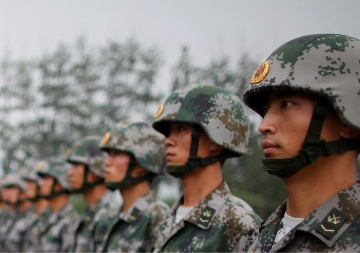“The Islamic State Phenomenon: South Asia and Beyond,” a monograph published under ORF’s Strategic Studies Programme, was released in Mumbai on 31 August by Lt Gen Vinod Khandare, former Director General of the Defence Intelligence Agency and Mr V Balachandran, former Special Secretary, Cabinet Secretariat, Government of India. The monograph is authored by Mr. Kabir Taneja, an Associate Fellow.
Congratulating ORF and Kabir for compiling such “a well-researched” report, Mr Balachandran said that the monograph would help governments and security agencies across the world to gain a better and nuanced understanding of the ISIS phenomenon. He also said that one of the biggest concerns for the world was how to “handle” those who returned from their stint with the rogue organisation and their continued radicalisation upon their return. He also said that while many boys had returned, only five percent of the women who had travelled to ISIS territories had returned and even the UN is unaware about their whereabouts.
Citing a series of terror acts, Mr Balachandran pointed out that “The Islamic State has separate sets of propaganda for different regions of the world and this is clear in the method used in suicide bombings and other terror acts that have occurred across geographies from the United States to Indonesia”. He also threw caution on the dangers of propaganda “even after the decline of the organisation’s regional control by 62 percent”.
Lt. Gen. Vinod Khandare began by emphasising that the ISIS had failed to make any serious impact in India. “Even in Kashmir, where – given the current situation – one would imagine the ISIS phenomenon being welcomed, the ISIS had made zero inroads. “Kashmiriyat and the ideology of ISIS don't align,” he said, and explained the inherent contradiction between the two. He validated his argument by pointing out that the ORF’s monograph, “one of the most authoritative research undertaken on ISIS,” had not found a single case of an ISIS recruit from Kashmir. “Through my long years of service in the Kashmir Valley, I have realised that waving of ISIS flags during agitations in Kashmir is nothing more than a photo-op for miscreants,” he said. Lt. Gen. “Kashmiris are fighting their own battle – irrespective of the logic behind their objective and if anyone tries to introduce a new concept, the locals become very suspicious, assuming it to be a tactic of the Indian intelligence agencies and go on to weed it out.”
Inquiring into the pursuits of ISIS in South Asia, Lt. Gen. Khandare stated that they desired not oil or money but ‘cannon fodder’ from the region. They need recruits for fighting and the most populated region in the world would be the obvious choice, he explained. Evaluating the prospects of the South Asian countries in facing the ‘ISIS phenomenon’, he took the example of how Pakistan, with its ongoing Kashmir agenda, would be apprehensive to a foreign body brainwashing and recruiting away its youth. Afghanistan, a theater of multiple powers battling to gain control of the territory was also a tough recruitment ground for ISIS. In India, thanks to the close family and community ties, on several occasions, we have instances where parents have themselves alerted the security agencies about their wards behaving suspiciously. “The parents would rather have their wards locked up than being killed in a battle in some foreign land,” he pointed out.
On the other hand, countries such as Maldives and Bangladesh were fertile grounds for the ISIS and the region could see some larger degree of influence of ISIS given the swelling Rohingya crisis and how large sections of the vulnerable population of Iran would react to the increasing sanctions and a possible conflict with the United States. “With an already troubled neighborhood, the spillover from a region in turmoil could create grave insecurities for India,” he cautioned.
Earlier, Kabir Taneja gave a presentation, giving a detailed description on the functioning of a dynamic tracker, conceptualised in 2015, that followed the latest updates on the activities of ISIS in India. The tracker, updating every 48 hours, classifies the data by year and state, also making records of the major activities of the terror group within the extended South Asian region. He then went on to give an overview of the current status of ISIS and the Syrian conflict, which was compiled in three different reports prepared during the past three years and published as a single monograph.
The first report, ‘Understanding ISIS: From Conception to Operations’ is a primer, that deals with the inception of ISIS, role of Zarqawi and their operations from a West Asian perspective. Citing a BBC interview of a journalist captured by ISIS, Kabir explained that adorning the front-page headlines in the western publications were celebrated as massive victories by the terror group. “ISIS was popular through strategy not accident,” he said. The second paper ‘Fall of ISIS and its Implications for South Asia’ deals with how the ‘ISIS phenomenon’ affected South Asia with special attention given to Bangladesh and Afghanistan where ISIS had prominent influence highlighting the role of ISKP, an organisation that inherited the ISIS moniker.
Kabir Taneja said that his third report, ‘Uncovering the Influence of ISIS in India’, has managed to register only 117 cases of suspected ISIS recruits – “a negligible figure” compared to other countries. This was due to the fact that the organisation made no concentrated effort to build an offshoot in India but it is difficult to ascertain their motives at this time. While the study did reveal a common aspiration among individuals to travel to Syria and join ISIS, there was no single pattern or trend that could help ascertain the real objective. “Of all the 117 cases, no two cases were similar,” he said, adding that “the Islamic State propaganda affected every individual in different ways and even the ISIS does not have any control over it.”
This report was prepared by Navin Narang, Research Intern, Observer Research Foundation, Mumbai.
The views expressed above belong to the author(s). ORF research and analyses now available on Telegram! Click here to access our curated content — blogs, longforms and interviews.




 PREV
PREV

